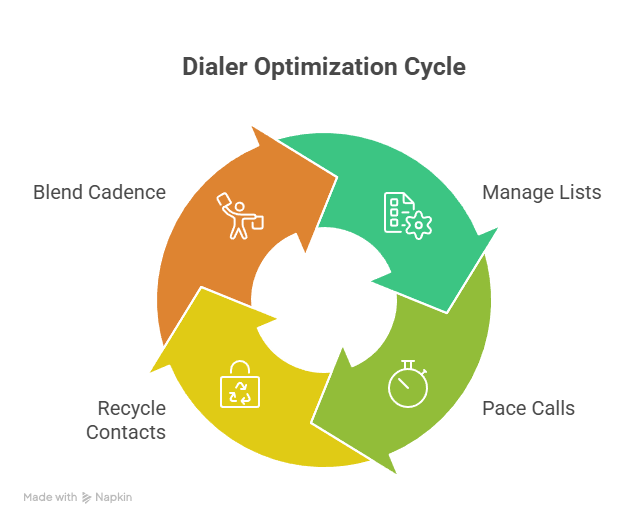If your “phone system” still means closets of gear, vendor tickets, and change windows that need pizza, you don’t have telephony—you have technical debt with ringtones. A modern cloud PBX removes the racks, the regional lock-in, and the change-fear, then replaces them with active-active edges, carrier diversity, ironclad compliance, and an events model you can actually report on. This is the field manual for getting from fragile boxes to global voice as a service—the same discipline used by teams that treat uptime like oxygen and ActiveCalls as the operating backbone.
1) Architecture That Doesn’t Break: Edges, Carriers, Sessions, and State
Great phone systems don’t rely on hope; they rely on layers.
Active-active edges (multi-region). Traffic lands at the nearest healthy point of presence (POP) with per-second liveness probes. If an edge wobbles (carrier incident, ISP brownout, localized cloud blip), sessions drain and rehome without a war-room.
Carrier diversity & smart routing. No one carrier owns your dial tone. SIP OPTIONS health checks, real-time route re-selection, and per-country trunks eliminate the “single glass cable” risk. For outbound, STIR/SHAKEN keeps CLIs trustworthy; for inbound, DID inventory spans regions with number portability playbooks.
Session resilience at the edge. Real humans sit on flaky Wi-Fi and tethered 4G. Your PBX must auto-recover WebRTC sessions, renegotiate codecs under jitter/loss, and maintain call survivability through network micro-cuts.
State & events, not spreadsheets. Every call is a chain of immutable events (CallStarted → Ringing → Connected → Transferred → Held → Wrapped → Dispositioned). That’s how you reconcile “what happened” at audit time and generate exec-safe dashboards that match finance.
Security by default. TLS/SRTP end-to-end, SSO/SAML, role-based access (RBAC), least-privilege media access, and immutable audit logs. Recordings encrypted at rest with per-tenant keys; access governed by data policy, not tribal knowledge.
Why this matters: When these layers are real (not slideware), outages become non-events, and telephony stops consuming mental bandwidth. That’s the point.
| Requirement | Legacy PBX Failure Mode | Cloud PBX Fix |
|---|---|---|
| Active-active uptime | Single DC; failover = outage | Multi-region edges with per-second health checks |
| Carrier resilience | One telco to rule (and ruin) you | Diverse trunks + auto route re-selection |
| Emergency calling | Manual addresses; misroutes | Enforced dispatchable E911/E112 per site/device |
| QoS under jitter/loss | Dropped calls, robot voices | Adaptive jitter buffers, codec renegotiation |
| WebRTC softphones | Plugins, installs, “it works on one laptop” | Browser-native clients with auto-reconnect |
| Desk phone lifecycle | SFTP confs, manual firmware | Zero-touch provisioning + OTA firmware |
| Number management | Tickets, week-long waits | Self-serve DIDs, instant routing |
| Outbound reputation | Spam flags, unknown CNAM | Verified CNAM, STIR/SHAKEN A, CLI rotation |
| IVR experience | Dept trees, rage quits | Intent-first flows + 0-to-agent |
| ACD efficiency | Round-robin roulette | Skills & priority with backlog inputs |
| Callbacks that keep promises | Anytime tomorrow (maybe) | Windowed callbacks + priority re-queue |
| Change safety | Weekend windows, fingers crossed | Flags, staged deploys, one-click rollback |
| Security & access | Shared logins; CSV “audits” | SSO/SAML, RBAC, immutable logs |
| Recording policy | All or nothing, wrong people listening | Per-queue policy, encryption, role-gated access |
| PCI/HIPAA handling | Muted mics, human error | Pause/resume + field redaction automation |
| GDPR compliance | No deletion path; data sprawl | Consent, residency options, erasure workflows |
| Analytics truth | Reports that never match | Canonical events → reproducible views |
| Cost control | Telecom fog | Tags by LOB/site; forecast vs actuals alerts |
| Integrations | CSV Tuesdays | Webhooks + native CRM/ITSM connectors |
| Site survivability | ISP down = dead phones | SBC survivability + PSTN breakout |
| Admin ergonomics | SSH & vendor calls | Policy-driven, UI + API in minutes |
| Global latency | Everyone hairpins via HQ | Nearest POP media anchoring |
| SIP trunk sprawl | Contract soup, hidden fees | Centralized trunks + transparent pricing |
| Audit readiness | Scramble mode | Pre-built evidence bundle + reports |
| WFM alignment | Staffing blind spots | Events → SL/ASA feeds for WFM |
| Outbound compliance | Manual rules; accidental violations | Hard windows, attempt caps, suppression lists |
| Quality & coaching | Random reviews, no change | Risk-based sampling + 5-behavior rubric |
| Disaster recovery | Tape backups and prayers | Cross-region failover + tested runbooks |
2) Numbers, Devices, and Global Presence Without the Paperwork
The old world: procurement tickets, “we’ll get you a number next week,” and PBX admins hand-programming phones. The new world: just-in-time numbering, device profiles, and global footprints a single admin can manage.
DIDs & local presence. Spin up country-appropriate numbers and localized CNAM in minutes. Route at the edge nearest the caller to reduce latency and preserve audio quality. For outbound, run clean verified number pools and automatically retire “tired” CLIs that attract spam flags.
Emergency calling (E911/E112) at scale. Address provisioning must be enforced by policy (no device activation without a validated emergency address), with per-site dispatchable location. Emergency calls always route via compliant trunks with call-path priority, recording suppression (if required), and post-incident reporting.
Device management that isn’t a career. Support WebRTC softphones (zero install), approved headsets, and managed desk phones with over-the-air firmware, auto-provisioning templates, and feature packs. BYOD? Lock down with device posture checks, DTLS-SRTP, and token-bound sessions.
Survivability where it matters. Remote sites? Use lightweight survivable gateways (SBCs) that cache registrations, maintain PSTN breakout for emergency, and fail open to cellular if the ISP dies.
Why this matters: You stop waiting on telcos and start treating numbers/devices as software objects that bend to policy. No tickets. No mystery.
3) Routing, IVR, and ACD: From “Press 9 for Pain” to “Instant, Intent-First”
Routing is the real UX. People remember latency and outcomes, not your brand promise.
Intent-first IVR. Model flows by jobs-to-be-done: start order, track/return, billing, tech help. Keep depth shallow, wording plain, and “0 to agent” available. Push obvious deflections to self-service but never trap.
Skills-based ACD with reality inputs. Route on language, entitlement, product, and current backlog. If one intent starts consuming 40% of lines, the system reprioritizes the queue; leadership doesn’t write memos—ops flips a lever.
Sticky, but not forever. Give callers agent and queue stickiness to finish work, with time-boxed fallbacks to avoid black-holes.
Smart callbacks. Offer windowed callbacks when ASA > threshold. Enforce promises: when the clock hits, your callback enters the queue with priority.
Outbound that avoids flags. Align dialing mode with contactability & compliance, pace by live connects, rotate verified CLIs, and watch connect% vs. new CLIs daily. When reputation dips, the platform throttles.
Why this matters: The gap between 25-minute purgatory and “they picked up fast and solved it” is routing discipline plus guardrails the system can enforce in real time.
4) Migration Without Nightmares: From On-Prem PBX to Cloud in 6–8 Weeks
The fastest way to fail a migration is to run a “big bang.” The fastest way to win is pilot → parallel → wave ports, with rollback baked in.
Week 1–2 (Pilot & Proof). Stand up a non-critical queue, issue WebRTC softphones to 10–20 users, and route a new DID through the cloud IVR/ACD. Validate MOS/jitter/loss, feature parity, CRM sync, and E911 correctness. Build the cutover runbook.
Week 3–4 (Parallel Run). Bring inbound through the cloud IVR with legacy fallback. Push outbound for one team via cloud trunks. Keep a war-room chat, publish a change calendar, and test carrier failover live (proof beats promises).
Week 5–6 (Wave Ports). Port numbers by site/LOB, verify routes, and flip SBC registrations. Keep the rollback CLI ready (not theoretical). Train supervisors on routing levers and callback discipline.
Week 7–8 (Retire Legacy). Decommission TDM/SIP gateways, archive CDRs and configs, close maintenance contracts, and freeze old change windows.
Success criteria: No missed emergency calls, green MOS, equal or better SL/ASA, and exec dashboards all reconcile. If one metric doesn’t reconcile, you fix the model, not the narrative.
5) Analytics, Cost, and Governance: Make Finance Love Your Phones
Executives don’t want pretty charts—they want permission to allocate budget. You earn that with an events model, unit economics, and policy you can prove.
Events → views → truth. Emit canonical events (Start/Connect/Transfer/Wrap/Disposition). Join to Agent, Queue, Site, Campaign, CRM Object. Build intraday ops views (SL/ASA/adherence), cohort views (AHT/FCR/CSAT by intent/agent), and business views (revenue/contact, collection per call, meetings/100 connects). If a metric can’t be reproduced across these views, it doesn’t ship.
Cost transparency. Break cost down by minutes, seats, channels, carriers, and departments. Set alerts on “forecast vs actuals,” and tag traffic by LOB/country so finance can reallocate spend with confidence.
Governance you can show auditors. Document data retention, recording encryption/keys, access reviews, and pen-test summaries. Provide BAAs (HIPAA), lawful basis (GDPR), DNC controls (TCPA-like), and erasure workflows. Don’t bury this; publish it in your security pack.
Why this matters: With reproducible numbers and provable policy, voice stops being “the risky black box” and becomes an investable channel.

6) Reliability & Compliance: Pass Every Review, Sleep Through Every Night
This is the part buyers care about more than features.
Reliability by design. Multi-region edges, carrier diversity, health-checked failover, and session resilience are table stakes. Add change discipline: feature flags, staged deploys, and one-click rollback that’s exercised monthly, not “if needed someday.”
Transparency that builds trust. Live health pages (MOS/jitter/loss by region), incident comms with timestamps and remediation, and postmortems that change checklists. When reliability is visible, skepticism fades.
Compliance defaults. Pause/resume or PCI redaction at field-level, GDPR consent and residency options, immutable logs, role-based review access for recordings, and auditable exports to your archive. For healthcare, deliver BAAs and least-privilege. For finance, enforce hard calling windows, consent capture, and audit trails.
Global scale without gotchas. Country-level routing, codec policies, POPs where users are, lawful intercept readiness (where required), and number inventory that won’t strand you during campaigns.
Why this matters: Reliability is not a slide. It’s the difference between “phones seem fine today” and “we ship revenue on schedule.”
7) PBX FAQs — Answers That Change Outcomes
1) How fast can we migrate without risking emergency calling or SLAs?
Run pilot → parallel → wave ports in 6–8 weeks. Validate E911/E112 addresses and test a real carrier failover in the pilot. During parallel, route inbound via cloud IVR with legacy fallback; move one outbound team to cloud trunks. Port by site/LOB with a rollback CLI staged. Success = green MOS, correct emergency routing, and equal/better SL/ASA.
2) Do we need desk phones, or can we go 100% softphone?
Softphone-first works for most teams: WebRTC clients, posture checks, and approved headsets. Keep managed desk phones for regulated floors, shared spaces, and executive areas as needed. Use device profiles and OTA firmware either way so ops doesn’t hand-configure anything.
3) How do we stop outbound numbers from getting flagged as spam?
Use verified CNAM, maintain clean CLI pools, rotate numbers, and throttle attempts when connect% dips. Keep STIR/SHAKEN A, watch connect% vs. new CLIs daily, and retire “tired” numbers. Align dialing mode with compliance; avoid over-pacing that triggers abandon spikes and flags.
4) What’s the minimum security/compliance bar for enterprise PBX today?
TLS/SRTP, SSO/SAML, RBAC, immutable audit logs, encrypted recordings with per-tenant keys, and documented PCI/HIPAA/GDPR controls (pause/resume, field redaction, consent, residency, erasure). Provide pen-test summaries, data maps, and incident runbooks up front.
5) Our execs don’t trust the phone metrics. How do we create one source of truth?
Stream canonical events to your warehouse, join to Agent/Queue/Site/CRM, and publish three synced views: intraday ops, cohort trends, and business attribution. If numbers don’t reconcile across views, fix the model—don’t spin narratives. Trust follows reproducibility.
6) How do we guarantee emergency calls always work—for WFH too?
Enforce dispatchable addresses at activation, require WFH address updates on location change, and block activation for devices without a validated address. Route emergencies via compliant trunks with priority, suppress recordings where required, and audit monthly with documented test calls.
7) Can we keep a few legacy trunks/SBCs for special sites?
Yes—run hybrid. Cloud anchors media/signaling, while site SBCs provide survivability, analog bridges (fax/alarms), and PSTN breakout. Keep contracts minimal and plan a 12-month sunset so “temporary” doesn’t become forever.
8) What does a healthy global PBX look like—daily?
Edges green across regions, MOS ≥ 4.0, jitter/loss within policy, connect% stable, emergency test logs clean, change calendar published, and no manual data fixes in reporting. Supervisors run two routing tweaks and one QA calibration per week—no fire-drill ops.
90-Day Cloud PBX Program (That Actually Finishes)
Days 1–14 (Foundations). Stand up edges, verify carrier diversity, enable TLS/SRTP, SSO, and RBAC. Pilot a non-critical queue. Validate MOS/jitter/loss, E911, and recording policy. Publish the cutover runbook and change calendar.
Days 15–45 (Parallel Reality). Route inbound via cloud IVR with fallback; move one outbound team. Train supervisors on skills, priority, callbacks. Test a live failover and capture the evidence bundle. Begin events streaming to your warehouse.
Days 46–90 (Scale & Retire). Wave ports by site/LOB. Switch desk phones to OTA provisioning; enforce device posture for softphones. Publish exec dashboards tied to events. Decommission old trunks, archive configs, and close maintenance. Your PBX is now software.
Final Word
Cloud PBX isn’t about moving a box to someone else’s data center; it’s about eliminating boxes entirely—and with them, the outages, paperwork, and analytics theater. When you run this playbook on a platform like ActiveCalls, telephony becomes predictable infrastructure: global, compliant, visible, and boring—in the best way. That’s how you stop losing sleep over phones and start shipping revenue on schedule.








